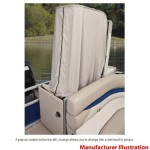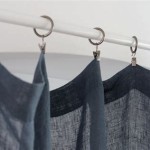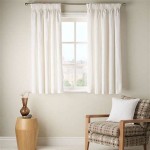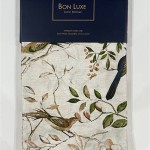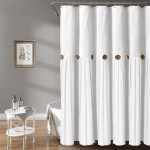The Aesthetic and Functional Impact of Single-Panel Curtains on Windows
Single-panel curtains offer a versatile and often cost-effective window treatment solution for a multitude of spaces. Unlike traditional curtain pairs, a single-panel curtain, as the name suggests, consists of just one fabric panel covering a window. This design choice can significantly influence a room's aesthetic, light control, and overall functionality. The decision to employ a single-panel curtain hinges on a variety of factors, encompassing window size, desired level of light diffusion, and the intended style of the room. This article will explore the aesthetic and practical implications of using single-panel curtains, examining their suitability for different window types and interior design schemes.
The selection of a single-panel curtain requires careful consideration of the fabric’s properties. Heavier fabrics, such as blackout materials or thick velvets, offer superior light blockage and insulation properties, making them ideal for bedrooms or home theaters. The inherent heft of these fabrics also contributes to a more dramatic and luxurious drape. Conversely, lighter fabrics, such as sheers and linens, provide a softer, more diffused light, suitable for living rooms or kitchens where natural light is desired. The color and pattern of the fabric should also complement the existing décor; a bold, patterned single-panel curtain can act as a focal point, while a neutral-toned panel can blend seamlessly with the surrounding elements.
Beyond the fabric, the hanging style of the single-panel curtain significantly impacts its functionality and visual appeal. Options range from rod-pocket curtains, which offer a simple and gathered look, to grommet-top curtains, which provide a more modern and streamlined appearance. Tab-top curtains present a casual and relaxed style, while using rings with clips allows for easy adjustment and a more tailored aesthetic. The length of the curtain is equally important; a curtain that just brushes the floor offers a classic and elegant look, while a slightly shorter curtain is more practical in high-traffic areas or where children and pets are present. A "puddling" effect, where the curtain fabric pools on the floor, adds a touch of drama but requires more maintenance.
Aesthetic Considerations: Streamlining the Visual Landscape
One of the key advantages of utilizing a single-panel curtain is its ability to create a streamlined and uncluttered visual space. In smaller rooms, two curtain panels can sometimes overwhelm the window, making the space feel cramped. A single-panel curtain, especially when strategically placed to one side, can create the illusion of a larger window and a more open feel. This is particularly effective in rooms with multiple windows, where using single panels instead of pairs can simplify the overall aesthetic and prevent the space from feeling visually busy.
The placement of the single-panel curtain is paramount to achieving the desired aesthetic effect. Generally, it is recommended to position the curtain on the side of the window that receives the most light or offers the least appealing view. This allows the curtain to effectively block unwanted light or obscure an unattractive outlook while still maximizing the available natural light entering the room. For example, if a window faces a busy street, positioning the single-panel curtain on that side can help to minimize distractions and create a more peaceful atmosphere.
Furthermore, the choice of hardware plays a critical role in the overall aesthetic. A simple, understated curtain rod can complement a minimalist décor, while a more ornate or decorative rod can add a touch of elegance and sophistication. The color and finish of the hardware should also be carefully considered to ensure it harmonizes with the fabric and the other elements in the room. For instance, a brushed nickel rod can complement a modern, industrial-inspired space, while a wooden rod can enhance a rustic or traditional aesthetic. The finials, or decorative ends of the curtain rod, also offer an opportunity to add a personal touch and enhance the overall visual appeal.
Functional Aspects: Light Control and Privacy Management
Single-panel curtains offer a practical approach to light control and privacy management. The degree of light filtration depends primarily on the fabric’s density. Sheer fabrics provide minimal light blockage, allowing natural light to gently filter into the room while still offering a degree of privacy. These are well-suited for areas where natural light is desired but direct glare needs to be minimized. Opaque or blackout fabrics, on the other hand, offer maximum light blockage, making them ideal for bedrooms where darkness is essential for sleep, or for home theaters where glare needs to be completely eliminated.
The operation of a single-panel curtain also influences its functionality. A tie-back can be used to hold the curtain open, allowing for maximum light exposure during the day. Conversely, the curtain can be fully drawn to provide complete privacy and light blockage. The ease with which the curtain can be opened and closed depends on the hanging style and the smoothness of the rod. Grommet-top curtains tend to slide more smoothly than rod-pocket curtains, making them a better choice for situations where frequent adjustments are necessary. The use of curtain wands can also facilitate smooth and effortless operation, especially for heavier fabrics.
In terms of privacy, single-panel curtains can be particularly effective when strategically positioned. By placing the curtain on the side of the window facing a neighboring building or a busy street, a significant degree of privacy can be achieved without completely obstructing the view. The density of the fabric plays a crucial role here; thicker fabrics offer greater privacy levels compared to sheer fabrics. The height and width of the curtain should also be carefully considered to ensure that the entire window is adequately covered, minimizing any potential for unwanted visibility from the outside.
Suitability for Different Window Types and Room Styles
The versatility of single-panel curtains makes them suitable for a wide range of window types and room styles. For smaller windows, such as those found in bathrooms or kitchens, a single-panel curtain can be a more practical and aesthetically pleasing solution than two panels. It avoids overwhelming the window and can be easily adjusted to control light and privacy. For larger windows, such as those in living rooms or bedrooms, a single-panel curtain can create a dramatic and stylish statement, especially when made from a luxurious fabric and hung from an attractive rod.
In terms of room styles, single-panel curtains can be seamlessly integrated into various design schemes. In minimalist interiors, a simple, unadorned single-panel curtain can enhance the clean lines and uncluttered aesthetic. In bohemian-inspired spaces, a macramé or embroidered single-panel curtain can add a touch of texture and visual interest. In traditional settings, a heavier fabric with a classic pattern can create a sense of elegance and formality. The key is to choose a fabric, color, and hanging style that complements the overall design of the room.
Bay windows present a unique challenge, but single-panel curtains can still be effectively utilized. Instead of using multiple panels to cover each individual window pane, a single, wider panel can be hung to one side of the entire bay window arrangement, creating a focal point and allowing for maximum natural light. This approach works particularly well when the bay window offers a pleasant view, as it allows the view to remain largely unobstructed while still providing the option of privacy and light control when needed. The single-panel curtain can be tied back during the day to fully expose the bay window and then drawn closed at night to create a cozy and intimate atmosphere.

One Panel Curtain Per Window

Looking For Ideas On How To Make It Work With Just One Panel Curtain Per Window Description From Pinterest Com I Searched This Bing Images

Choosing One Or Two Curtains To Cover Your Window

17 Best Single Side Drape For Bedroom Ideas House Design Home Decor

Curtains And Dealing With Problem Windows Cedar Hill Farmhouse

Single Curtain Panel Designer Picks 190 Real Photos

Designer Trick How To Hang Drapery Panels For Maximum Impact

One Curtain Panel On Window Ideas

Terracotta Tassels One Panel Curtain Fringes Door Honey Bohemian Curtains Window Boho Bedroom Etsy

The Do S And Don Ts Of Curtain Placement Nadine Stay

